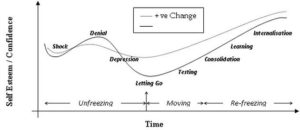The current generation of working professionals are bound to experience professional turmoil of some kind during their careers. Closure of firms, mergers, acquisitions and down-sizing are a sign of the times. Change is the norm for survival for industry and the trauma of severance, retrenchment and lay-offs is a familiar feeling at the work-place. World-over, companies and individuals pro-actively prepare for periods of uncertainty by making efforts to identify options or acquire new skills or qualifications to help them succeed elsewhere.

Any job has an emotional association attached to it by virtue of a person considering himself / herself as an extension of that organisation for a while. The work itself maybe something very close to the person’s heart or he or she may not want to give up the responsibility and power associated with it. Dependency on the earnings is usually the least of reasons to fear severance, as usually the insecurity stems from a lack of self-confidence / the ability to find an alternative job. In broader terms the determinants of anxiety related to severance are:-
- A parochial self-interest or a belief of a personal loss – of power, position or influence.
- A misunderstanding as to the implications.
- A lack of trust in the initiator/organisation, leading to a perception of being victimized.
- An assessment of the situation different from that of the initiator/organisation where the perceived benefits of the severance to the organisation appear unjustified.
- Inability to cope with changed requirements as people are limited in their ability to change. This includes the inability to develop new skills or behaviours or to make the emotional transition.
- A fear of being out-dated or too old to find a job.
So how do people deal with this anxiety? Is it not possible that they can make better of a severance? How do organisations facilitate smoother transitions? The answers to these questions lie in understanding the stages of personal transition.
A Model of Personal Transition
On the face of a major change such as a job loss, portfolio reshuffle or transfer, people are faced with work-related uncertainty, going through a series of ups and downs in their state of mind (graphically an S curve of Self-esteem/Confidence over Time). This model offers insights as to how one can manage each stage effectively and suggests that while everyone goes through the same sequence of emotions, the degree or duration vary from person to person and over time.
Each stage is distinct, with some stages being far easier to deal with than others. Facilitating an easy transition largely depends on speeding up the early stages, while prolonging the later stages. This is achieved by preparing for the transition, exploring and understanding opportunities, re-skilling and actively pursuing resettlement opportunities inside/outside the organisation.

Shock is the first reaction to any organisational change and a person numbed by shock lacks initiative, energy or enthusiasm. He or she unable to respond to reason or external stimuli and the shock can only be mitigated by making the change gradual and anticipated. The organisation plays a key role in preparing its employees for the change and gradually introducing them to it.
It is only natural that shock be followed by denial, a refusal to accept what is imminent. The person appears to be in good spirits as a result of a conviction that “it will not happen” or “it cannot affect me”. However, there is in actuality an inner struggle to accept the change. In preparing employees, the true implications of the change need to be outlined and at the same time in a manner that facilitates acceptance.
Depression is a prelude to acceptance with the person irritable to the slightest provocation, displaying a deep sense of regret and a visible loss of interest in work/absenteeism. There is also a struggle to make sense of the situation. Counselling helps gaining sight of where they fit and what they should be doing. Outlining opportunities in the new order and personal strengths serve to improve confidence levels to overcome depression.
Letting go is the “turning point” in the transition process occurs at the lowest depths of depression. The person constantly reminisces of the past and associates with old colleagues. Communication on future prospects and new possibilities facilitates a quicker “let go”.
Testing of new ground is the beginning of constructive transition, where the person tries to help himself / herself by gathering information on new possibilities, taking risks and experimentation with new behaviours. The person displays initiative and energetically seeks alternatives and yet suffers swings from enthusiasm to discouragement. Encouragement is essential to make a successful transition / identify opportunities / suitable skills or behaviours.
Consolidation occurs alongside testing and gradually supersedes it. The person thinks and talks of new experiences and develops a more realistic picture of the future. However, it is important that testing should not stop too soon, to ensure evaluation of all options. Guidance to opportunities in accordance to skills and abilities facilitates a proper choice.
The last stage of learning and internalisation is a stage of reflectiveness, wherein the whole experience is treated as a period of learning with an effort to identifying actions for the future. In this stage it is important that person moves on with no regrets.
In India, performance-linked or competitive restructuring of companies has paved the way to “doing away” with people or positions that do not contribute to bottom-lines or for strategic reasons. When such a change is initiated by the organisation, people tend to resist instead of preparing for the inevitable. Even worse, few people past 35 years of age are likely to enroll in classes to acquire new skills. Yet the process of severance could be less-painful when people choose to make the transition themselves.
